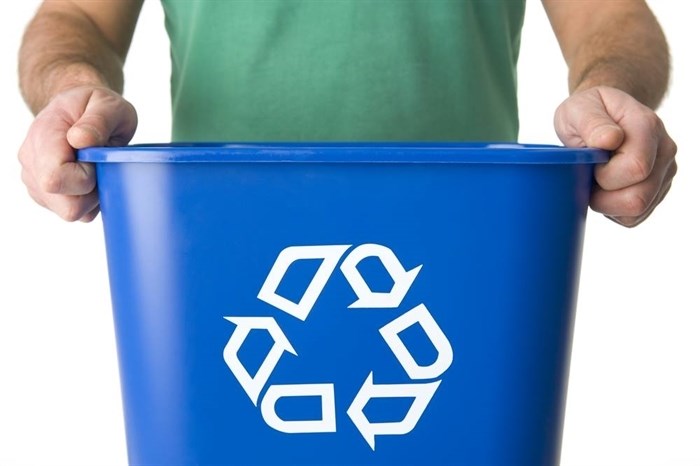
Image Credit: FILE PHOTO
May 03, 2022 - 7:30 AM
One bin makes it easier for Central Okanagan residents to recycle but three bins makes them do it better.
Over the next few weeks, all local governments in the Central Okanagan will be wrestling with what the future of recycling is going to look like.
It was the City of Kelowna’s turn to weigh in yesterday, May 2.
“Maybe we’re outliers here in this particular instance because 92% of people say they are satisfied with the current service,” Mayor Colin Basran said after almost two hours of listening to presentations on the Glenmore Landfill and the regional recycling program. “I’m one of them who isn’t.”
At issue is how recyclables are sorted.
In many B.C. cities the program is handled by Recycle B.C., a non-profit organization that oversees recycling in the province and is funded by fees charged to product users and manufacturers.
Generally that means householders sort their recycling in three different bins for things like cardboard, tin and certain plastics.
Recycle B.C. hires contractors to do that. If the material isn’t properly sorted, it’s left at the curb. That means the material is very “clean.”
In the Central Okanagan, there's an agreement in place for the region, and its member municipalities, to do the collecting and sorting, which means recyclables are “co-mingled” in one bin but things like glass, Styrofoam and certain plastics have to be dropped off at recycling depots.
The problem is, Kelowna residents have a 7.4% contamination rate rather than the 3% Recycle B.C. demands. While no fines have yet to be levied in the region, the City of Kelowna alone could be hit with fines of up to $480,000 per year, or $12 per user. That could be $780,000 a year for the region.
But some councillors worry that sorting may make people less likely to recycle at all.
“We could have a 0% contamination rate if people just throw everything in the garbage,” Coun. Brad Sieben said. “You must make this convenient for people to do it.”
But it's not just the fact that sorting systems are different, there was also concern about the fact that things like glass, in particular, can only be recycled at depots.
“You and I often joke, Coun. Sieben: ‘What did you do this weekend? Oh, I finally took recycling back that’s been piling up in my house because it can’t go in the bin.’ It makes no sense,” Basran said.
The agreement between the region and Recycle B.C. expires at the end of 2024 but has to be renewed, or not, by July of this year.
The decision, as laid out by staff, is to renew the agreement and have the regional district continue with the same system. That may come with increased costs because of fines and even more costs (an estimated $24 per year) if they add a curbside glass collection option. At this point, Recycle B.C. does not collect glass at the curbside without charging extra.
Or, the system could be turned over to Recycle B.C. which, at this point, is not saying exactly how it will collect the material just that it’s likely to be in three bins collected every two weeks.
Staff are not recommending either option right now but did say it's easier to educate people about clean recycling when using the multiple bin system.
While the decision on who will be responsible for picking up recycling from homes is some weeks away – and could be different in each municipality in the region – Sieben noted that it was timely to have the discussion at the same meeting where council was given an update on changes at the landfill.
After all, he noted, garbage from throughout the region is hauled to the city’s landfill so, if people don’t recycle as much, that material will be hauled to Glenmore.
Part of that discussion looked at the possibility of creating a curbside collection system for household food wastes, as is done in many other cities. That's not something that's under Recycle B.C.'s jurisdiction so is a separate discussion.
READ MORE: 'We had no say': Not everyone pleased with Kamloops curbside organic waste pilot
Right now, food waste goes to the landfill where it breaks down and is collected as methane that is fed back into the FortisBC natural gas system.
Some concern was expressed about a decrease in the amount of gas generated if organics are diverted but, staff said, there’s enough material already buried to generate gas for another 15 years, just at a declining rate.
The most visible change in 2025 will likely be either a three-bin system or higher costs. A more immediate change may be the curbside glass pickup, for a fee.
To contact a reporter for this story, email Rob Munro or call 250-808-0143 or email the editor. You can also submit photos, videos or news tips to the newsroom and be entered to win a monthly prize draw.
We welcome your comments and opinions on our stories but play nice. We won't censor or delete comments unless they contain off-topic statements or links, unnecessary vulgarity, false facts, spam or obviously fake profiles. If you have any concerns about what you see in comments, email the editor in the link above.
News from © iNFOnews, 2022